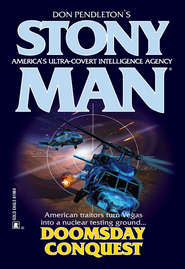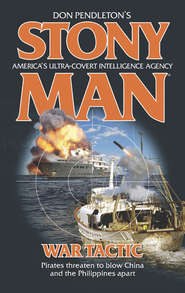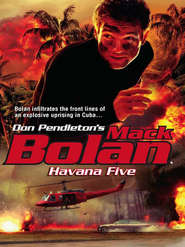По всем вопросам обращайтесь на: info@litportal.ru
(©) 2003-2025.
✖
Patriot Strike
Автор
Год написания книги
2019
Настройки чтения
Размер шрифта
Высота строк
Поля
“Not all. The basics,” Bolan answered. “I was told you’d fill me in.”
“Right here?”
“Your call,” Bolan said. “We can take a walk, a ride, whatever.”
“You weren’t followed?”
“No.” He’d spent some forty minutes driving aimlessly through San Antonio to guarantee it.
“I guess this is as good as anyplace,” she said. “But maybe we could step out of the light.”
As if on cue, a set of high beams blazed to life, pinning them where they stood. Bolan made out the hulking shape of what appeared to be a full-sized SUV, charging from its hiding place behind the screen of trees surrounding Alamo Plaza. It hadn’t trailed Granger’s Dodge, meaning it had been in place before the meet, its occupants apprised of when and where to strike.
“You said—”
“They didn’t follow me,” Bolan assured her, as his Glock cleared armpit leather.
Adlene Granger drew her own sidearm, a Heckler & Koch HK45, and raised it in a firm two-handed grip. “I can’t believe I missed them, damn it!”
“Who says you did?”
“But—”
“We should go,” he told her.
“They’re between us and my ride,” she said.
“Not mine,” he said. “Come on.”
She almost seemed reluctant not to stay and fight it out, but turned and followed Bolan at a sprint, the SUV roaring across the parking lot behind them. The headlights tracked them until they cut around the rear end of the Alamo and ran into another line of trees.
“What about my car?” she called to Bolan.
“We’ll come back for it,” he said. Skipped the obvious, not adding, if we can.
A twelve-gauge blast echoed out behind them, buckshot chipping the flagstone walk that had been laid around the old mission-cum-fortress. It was hasty, not a good shot, but they couldn’t count on someone with a shotgun missing them consistently.
Bolan was grateful for the cover when they reached the tree line, doubly glad that architects and landscapers hadn’t designed any access to the property on this side of the Alamo. Unless the SUV was supercharged, with a bulldozer blade attached, its driver would be forced to turn around and circle north or south around the plaza to pick up their trail.
It was a lucky break, but nothing more. They still had two long blocks to cover before they reached his rental on Crockett Street. The shooters could reverse their course and gain some ground, but they’d be confined to streets, while Bolan and the Ranger could run in a straight line, due south to his ride.
“Jesus!” Adlene Granger gasped, close on his heels. “If they knew I was coming here—”
She didn’t have to finish it. Prior knowledge meant a leak somewhere. It meant someone on her short list, one of the people she trusted, had no place there. Bolan, reasonably certain the tip hadn’t originated from his side, wondered how far the lapse would set them back.
Or whether it would get them killed.
They made it to the RAV4. Bolan keyed the automatic locks from half a block away, hearing the chime, seeing the taillights flash once. He slid behind the wheel, let Adlene take the shotgun seat and gunned the straight-four 1AZ-FSE engine. Peeling out on Crockett, eastbound, he saw headlights racing down Alamo Plaza, then turning to follow him.
So much for shaking the tail.
“Are you ready for this?” he asked Granger.
Half turned in her seat, pistol still in her hand, she replied, “Bet your ass.”
There it was then. Game time.
Chapter 2
Washington, D.C.—Earlier
Mack Bolan stood before the National Law Enforcement Officers Memorial, considering its four bronze lions—two male and two female—guarding a pair of cubs. Beneath each brooding cat he found a carved inscription. Tacitus, from ancient Rome, stated In valor there is hope. The Book of Proverbs reminded Bolan that The wicked flee when no man pursueth: but the righteous are as bold as a lion.
He wasn’t sure about the second part, having known some so-called righteous folks who didn’t have the courage of their own convictions. He could buy the first bit, though. The wicked could run, but they couldn’t hide.
At least not from the Executioner.
Bolan’s visit to Washington, and to this memorial in particular, was not a matter of coincidence. He wasn’t a casual tourist and most emphatically was not on vacation. He had come to meet one of his oldest living friends, a certified member of an endangered species, to discuss a matter of the utmost urgency.
Or so Bolan had been told.
This friend, Hal Brognola, had an office nearby, in the Robert F. Kennedy Department of Justice Building on Pennsylvania Avenue. Bolan had not seen it from the inside, and he likely never would. Although no longer wanted by the Feds and physically unrecognizable to those who’d hunted him during his long one-man campaign against the Cosa Nostra, Bolan knew that strolling through the halls of justice would be deemed a breach of etiquette. How could he be there, anyway, when he officially did not exist?
So, when he got an urgent call from Brognola, they either met at Stony Man—a working farm and the nerve center of the clandestine operation Bolan served, sequestered in the Blue Ridge Mountains—or at some public location in or near D.C. Crowds kept the pair of them anonymous, while they discussed their bloody business with a modicum of privacy.
Hiding in plain sight.
Today Bolan perused the names of fallen heroes who’d been shot, stabbed, bombed and bludgeoned while defending those in peril. Some had died in car crashes, during hot pursuits or when their aircraft had plummeted to earth on a surveillance mission. Others had succumbed to strokes or heart attacks on duty. Buildings had collapsed on some, as in New York on 9/11. Some had been cut down by friendly fire.
It was a war out there, as Bolan knew too well from personal experience.
He would have liked to say the good guys were winning, but each day the news refuted it.
Part of the memorial was still under construction—a National Law Enforcement Museum authorized in 2000 and scheduled to open in 2015. Bolan hoped he’d be around to visit it sometime. For now he stood and watched the workmen from a distance while a stocky figure sidled up to join him.
“Planning to pitch in?” Brognola asked.
“Not my kind of tools,” Bolan replied. He was more inclined toward the demolition side of things.
“Good flight?”
“The usual.”
Bolan had been in San Diego, visiting his brother, when the call from Washington had come through. A red-eye flight from San Diego International to Dulles, through Chicago O’Hare, had delivered him in time for breakfast and his meeting with Brognola.
“How’s Johnny?”
“Busy,” Bolan said. “What did they used to say at Pinkerton’s? The eye that never sleeps?”











